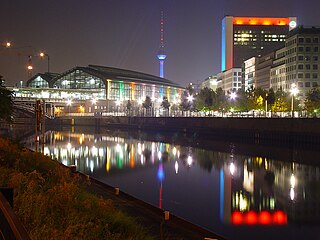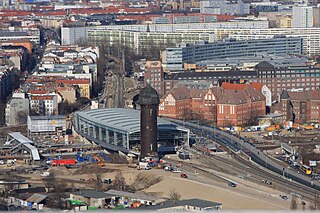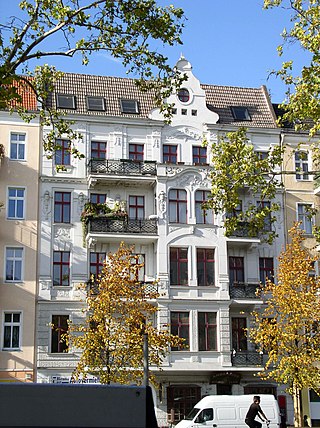| | |
|---|---|
| Overview | |
| Locale | Berlin |
| Service | |
| System | Berlin S-Bahn |
| Operator(s) | S-Bahn Berlin GmbH |
| Technical | |
| Electrification | 750 V DC Third rail |
The S86 was a line number used by the Berlin S-Bahn.
| | |
|---|---|
| Overview | |
| Locale | Berlin |
| Service | |
| System | Berlin S-Bahn |
| Operator(s) | S-Bahn Berlin GmbH |
| Technical | |
| Electrification | 750 V DC Third rail |
The S86 was a line number used by the Berlin S-Bahn.
This line number has been associated with four different routes during the last fifteen years.
The first version of the S86 was created on 2 June 1991, replacing the Brown route of the East Berlin S-Bahn between Buch and Warschauer Straße (via the eastern part of the Ringbahn). [1] [2]
The line was altered in May 1993 to run between Pankow and Hauptbahnhof (now Ostbahnhof), before being abolished in May 1994.
The line re-appeared as a night-time shuttle between Hermannstraße and Spindlersfeld in December 1999 before being removed again in June 2002. The line was re-introduced temporarily during construction works between September 2005 and May 2006.
Currently there are plans to again re-introduce the line as a permanent addition between Buch and Grünau replacing the S26 and S85, which will only happen if the S85 starts service towards the Central Station (Berlin Hauptbahnhof). [3]
This service ran for two years and provided an increased daytime service between Warschauer Straße and Buch. The line was extensively altered in May 1993 which effectively removed most of this service. The station listing below provides an overview of what the line looked like. The possible travel connections are correct for the period of operation and do not reflect the current travel connections for these stations.
In May 1993, the line was extended by one station to the Hauptbahnhof (now Ostbahnhof) with the northern section cut back to Pankow. This revised line existed for a single year when the line disappeared off the maps for a period of five years. The station listing below provides an overview of what the line looked like. The possible travel connections are correct for the period of operation and do not reflect the current travel connections for these stations.
In December 1999, the line re-appeared as a night-time shuttle service between Spindlersfeld and Hermannstraße. This short line ran between 9pm and 4am to provide Spindlersfeld with a link to the network when the (S85) finished for the night. The line lasted until June 2002 when the new (S47) line started serving Spindlersfeld both day and night rendering the S86 obsolete. The station listing below provides an overview of what the line looked like. The possible travel connections are correct for the period of operation and do not reflect the current travel connections for these stations.
During major construction works at Pankow station and in the north–south tunnel between September 2005 and May 2006, the S86 operated between Nordbahnhof and Birkenwerder to maintain a service to the outer railway ring stations. The line joined with the (S26) at Nordbahnhof for three weeks to provide a through service to Teltow Stadt from 8 May 2006 until 27 May 2006. The possible travel connections are correct for the period of operation and do not reflect the current travel connections for these stations.

Pankow is the second largest area of Berlin by population. In Berlin's 2001 administrative reform, it was merged with the former boroughs of Prenzlauer Berg and Weißensee; the resulting borough retained the name Pankow. Pankow was sometimes claimed by the Western Allies to be the capital of the German Democratic Republic, while the German Democratic Republic itself considered East Berlin to be its capital.

The Berlin S-Bahn is a rapid transit railway system in and around Berlin, the capital city of Germany. It has been in operation under this name since December 1930, having been previously called the special tariff area Berliner Stadt-, Ring- und Vorortbahnen. It complements the Berlin U-Bahn and is the link to many outer-Berlin areas, such as Berlin Brandenburg Airport. As such, the Berlin S-Bahn blends elements of a commuter rail service and a rapid transit system.

Warschauer Straße station is an S-Bahn and U-Bahn station on Warschauer Straße on the northern bank of the river Spree in the Friedrichshain neighborhood of Berlin, Germany. The two train stations as well as the trams that terminate adjacent to the U-Bahn station together accommodate over 85,000 passengers daily.

The S26 is a service of the Berlin S-Bahn. It runs from Teltow in the district (Kreis) of Potsdam-Mittelmark via Südkreuz, through the Berlin Nord-Süd Tunnel with a stop at Friedrichstraße, and ends in Blankenburg in the borough of Pankow. On weekends the S26 runs from Teltow to Potsdamer Platz. The current service began operation in December 2017.

Rummelsburg is a subdivision or neighborhood (Ortsteil) of the borough (Bezirk) of Lichtenberg of the German capital, Berlin.

The S10 was a line number used by the Berlin S-Bahn from June 1991 until December 1999. The line operated solely in the former East Berlin and was replaced by the S8 for the northern part of the route and the S47/S9 for the southern routing.
The S6 was a line number used by the Berlin S-Bahn from June 1991 until June 2002. The line always ran to the south-east corner of Berlin, although a number of routings were used during its period of operation. The line was replaced by the S46 and S9 which now provide connections to south-east Berlin.

Berlin Ostkreuz station is a station on the Berlin S-Bahn suburban railway and the busiest interchange station in Berlin. It is in the former East Berlin district of Friedrichshain, now part of the borough of Friedrichshain-Kreuzberg. A smaller part of the station is in Rummelsburg, part of the borough of Lichtenberg. The station is a Turmbahnhof with the Berlin–Frankfurt (Oder) railway and the Prussian Eastern Railway on the lower level and the Berlin Ringbahn on the upper level. It is used by a total of around 235,000 passengers every day on eight lines, entering or leaving.

The Rhine-Main S-Bahn system is an integrated rapid transit and commuter train system for the Frankfurt/Rhine-Main region, which includes the cities Frankfurt am Main, Wiesbaden, Mainz, Offenbach am Main, Hanau and Darmstadt. The network comprises nine S-Bahn lines, eight of which currently travel through the cornerstone of the system, a tunnel through central Frankfurt. The first section of this tunnel was opened on May 28, 1978. Further tunnel sections were opened in 1983 and 1990, before its completion in 1992. The system belongs to the Rhein-Main-Verkehrsverbund (RMV) and is operated by DB Regio, a subsidiary of Deutsche Bahn.

The Ringbahn is a 37.5 km (23.3 mi) long circle route around Berlin's inner city area, on the Berlin S-Bahn network. Its course is made up of a pair of tracks used by S-Bahn trains and another parallel pair of tracks used by various regional, long distance and freight trains. The S-Bahn lines S41 and S42 provide a closed-loop continuous service without termini. Lines S45, S46 and S47 use a section of the southern and western ring, while lines S8 and S85 use sections of the eastern ring. The combined number of passengers is about 400,000 passengers a day. Due to its distinctive shape, the line is often referred to as the Hundekopf.

Warschauer Straße is a major thoroughfare in the Friedrichshain-Kreuzberg district of central Berlin, the capital of Germany. The street begins at Frankfurter Tor to the north and spans 1.6km south to the intersection of the Oberbaumbrücke, Mühlenstraße and Stralauer Allee. The street acts as a section of Bundesstraße 96a and the Berlin Inner Ring Road. The street is named after Warsaw, the capital of Poland.

Mitte is a central section of Berlin, Germany, in the eponymous borough of Mitte. Until 2001, it was itself an autonomous district.

Gesundbrunnen is a locality (Ortsteil) of Berlin in the borough (Bezirk) of Mitte. It was created as a separate entity by the 2001 administrative reform, formerly the eastern half of the former Wedding district and locality. Gesundbrunnen has the highest percentage of non-German residents of any Berlin locality, at 35.1% as of the end of 2008.

The Tyrol S-Bahn, operated by ÖBB, provides regional rail services in metropolitan Innsbruck, Austria and its hinterlands in the state of Tyrol; and extended rail services into Italy and Germany.
The U11 line is a planned line of the Berlin U-Bahn.

S-Bahn Mitteldeutschland represents an enlargement of the previous Leipzig-Halle S-Bahn. It is an electric rail public transit system operating in the metropolitan area of Leipzig-Halle, Germany. This S-Bahn network developed from two separate S-Bahn networks of Halle (Saale) and Leipzig, which were established separately in 1969 and then linked in 2004. With the opening of the Leipzig City Tunnel on 15 December 2013 as a new artery, the network was extended for the first time to the federal states of Thuringia and Brandenburg. With a system length of 802 km (498 mi), it is the largest S-Bahn network in Germany, displacing the long-time title holder Rhine-Ruhr S-Bahn from that position. The locomotive-hauled double-decker trains partly dating back to the DDR-era have been largely replaced by electric multiple unit Bombardier Talent 2 trains, but some older trains are still used during rush hour.

The Berlin S-Bahn began on 8 August 1924 with the first section from Stettiner Vorortbahnhof to Bernau using steam locomotives. On 13 August 1961 it was broken up when the Berlin Wall was built, resulting in two sections: the eastern part and the western part. The western part experienced a massive strike which resulted in closure of several stations, after declining use. Attempts were made to reopen at various times but in the end, only three lines were finally opened after the strike. Since 9 November 1989, when the Berlin Wall was opened, the Berlin S-Bahn began to expand rapidly with their budgetary costs.

The Berlin U-Bahn originated in 1880 with Werner Siemens' idea to build an urban railway in Berlin. During the nine years after the German Empire was founded, the city's population grew by over one-third and traffic problems increased. In 1896, Siemens & Halske began to construct the first stretch of overhead railway. On 1 April 1897, the company began construction of an electric underground railway. The Berliner Verkehrs Aktiengesellschaft (BVG) was formed in 1928, and took over further construction and operation of the network. In 1938, the company was renamed Berlin Transport Company; the original acronym, however, remained. Since 1994, the BVG has been a public company.

The BVG Class 480 is an electric multiple unit for the Berlin S-Bahn. It was originally meant to replace the aging S-Bahn rail cars in West Berlin, but after the reunification of the city, the remaining orders were cancelled and replaced by new orders for DBAG Class 481 cars in 1993.